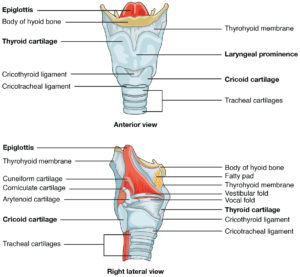
Laryngotracheplasty is used to treat tracheal stenosis or subglottic stenosis, which are problems with the airway. The procedure expands and repairs the airway using pieces of cartilage (grafts) taken from the rib, ear or thyroid. The windpipe is cut and expanded using the grafts, eventually growing healthy new tissue and widening the airway.
What is it?
This procedure is done to expand the airways in patients with tracheal stenosis or subglottic stenosis. Cartilage from other portions of the body such as the ribs, ear, or thyroid can be fitted and sewn into the trachea to expand its size. This allows for reconstruction of airways that are originally too narrow.
What should I do to prepare?
Begin preparation by informing your doctor/surgeon of any medications you are currently taking. You do not need to dramatically change your diet before the surgery, but it is helpful to eat healthy meals supplemented with iron. Prepare to have someone drive you to and from surgery, and it is preferable to arrange to have a caretaker for the first 24 hours.
What happens during the process?
This surgery requires patients to undergo general anesthesia. A horizontal incision is made at the appropriate site on the neck, and muscles are moved to allow the doctor to access the windpipe and voice box. A vertical cut is then made to open the trachea. The surgeons determine the size and shape of cartilage necessary and obtain it before fitting it into the trachea to expand it. A breathing tube is used to confirm correct positioning, with the entire operation lasting four to six hours.
What are the risks and potential complications?
This procedure involves risks as with any surgical treatment. One specific risk is the possibility of airway swelling leading to difficulty breathing. In addition, there is risk of infection, collapsed lung, endotracheal tube displacement, sore throat, nausea and vomiting.
Disclaimer:
All GlobeHealer Site content, including graphics, images, logos, and text, among other materials on the site are for educational purposes only. This content is not intended to be a substitute for professional medical advice, and you should always contact your physician or qualified health provider for information regarding your health. Information on this site regarding the overview, diagnosis, and treatment of any kind should be looked at, in addition to the advice and information of your health care professional. Do not disregard medical advice or delay seeking treatment or medical advice due to information found on the GlobeHealer site. If there is even the possibility that you may have a medical emergency, seek treatment, call your doctor, or call your local emergency telephone number immediately. GlobeHealer does not endorse being the first line of communication in case of emergency and does not endorse any specific test, physician, facility, product, procedure, opinion, or other information that is or may be mentioned on this site or affiliated entities. Reliance of any and all information provided by GlobeHealer, its employees, affiliations, others appearing on the Site under the invitation of GlobeHealer, or visitors of the site is solely at your own risk and is not the responsibility of GlobeHealer.
Image Source:
https://upload.wikimedia.org/wikipedia/commons/8/80/2306_The_Larynx.jpg
